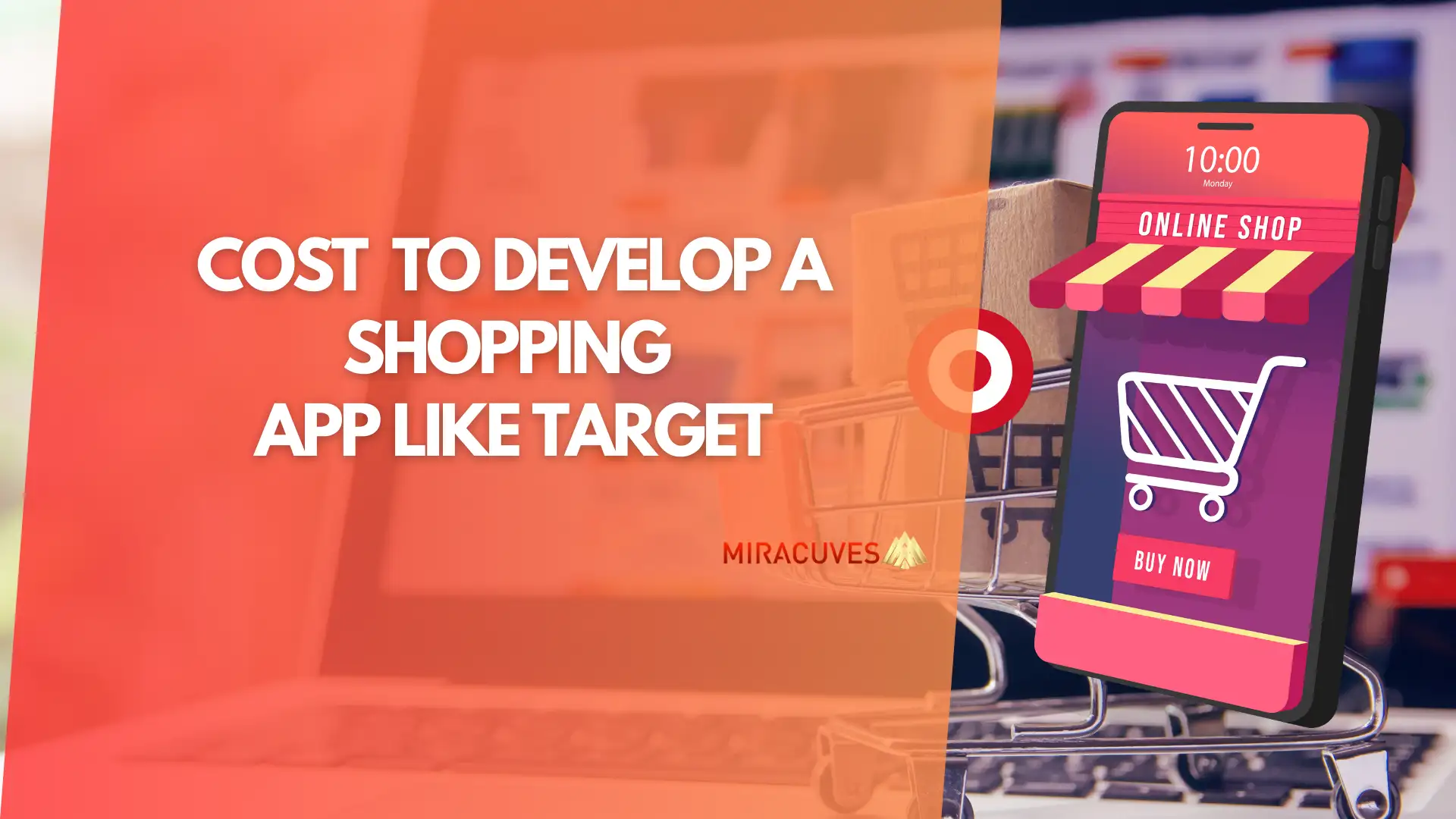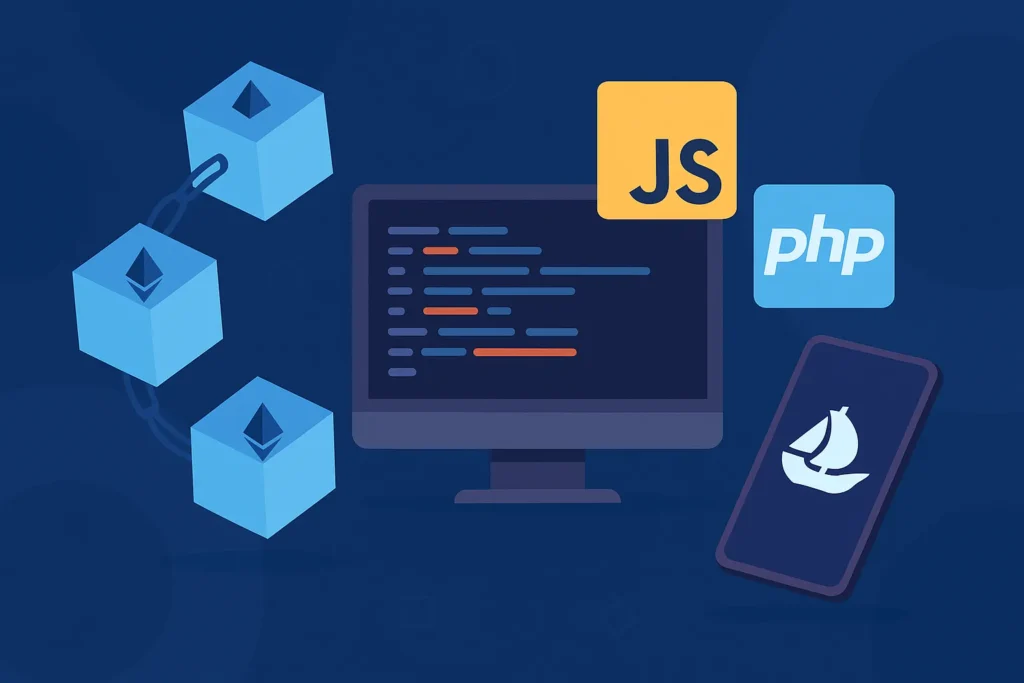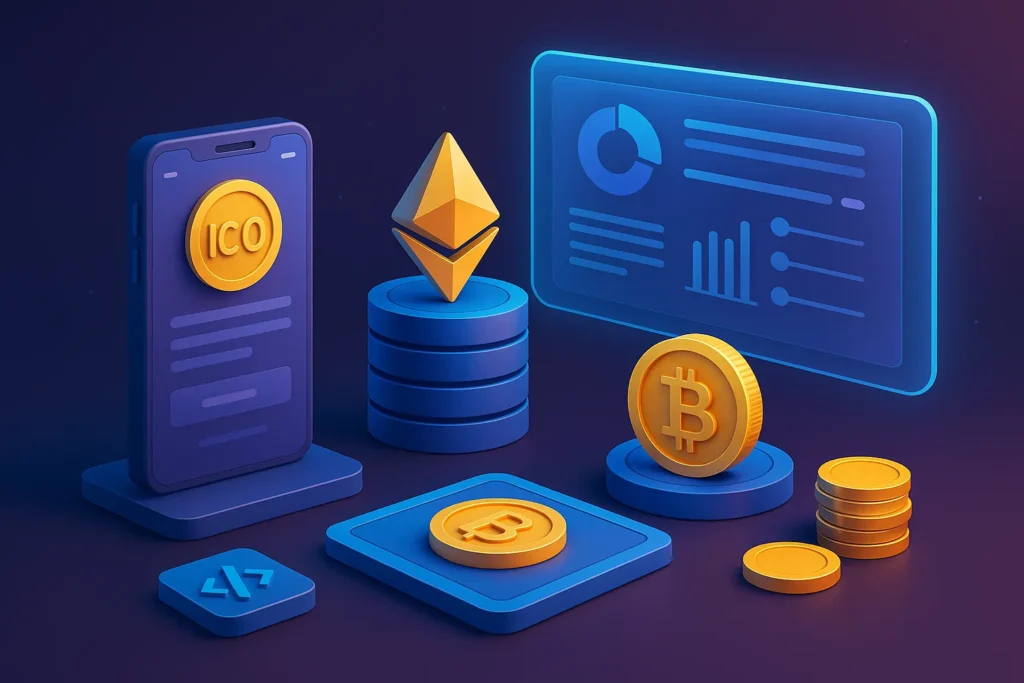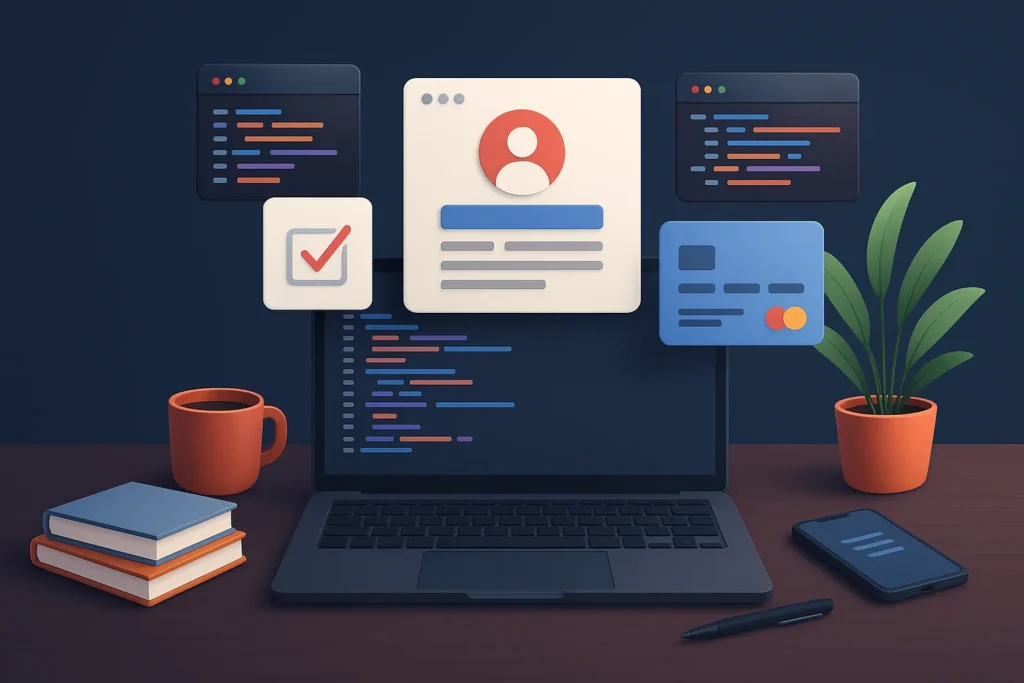In today’s fast-paced digital landscape, having a mobile shopping app is no longer a luxury but a necessity for retailers. As one of the leading retail giants, Target has perfected the art of providing a seamless shopping experience through its mobile app, offering a robust, user-friendly platform that millions of customers rely on. With features like personalized recommendations, fast checkout, and real-time tracking, Target’s app has become a benchmark for retailers looking to make their mark in the eCommerce space.
But how much does it really cost to develop a shopping app like Target? What are the factors that influence this cost, and how can businesses looking to build their own shopping app plan and budget effectively?
Developing a shopping app is not a one-size-fits-all process. It requires careful consideration of multiple factors like design, functionality, platform, and most importantly, the user experience. From initial market research to the integration of advanced technologies like AI-based personalized shopping features, the cost of building an app like Target can vary significantly.
In this guide, we’ll break down everything you need to know about the cost to create a Target-like app, including:
- The key features that make a shopping app successful
- The development process and timeline
- A detailed cost breakdown based on app complexity and platform
- Tips to reduce development costs without compromising on quality
By the end of this guide, you’ll have a comprehensive understanding of what it takes to build a Target clone app and how to approach the project efficiently.
1. Market Analysis and Why Build a Target-like Shopping App
The eCommerce market has seen exponential growth in recent years, with consumers increasingly shifting their shopping habits to mobile platforms. According to recent studies, mobile commerce accounts for more than half of all eCommerce transactions globally, and this number continues to rise. As shoppers demand convenience, speed, and personalized experiences, retailers are investing heavily in mobile app development to meet these expectations.
Building a shopping app like Target not only puts businesses in line with these evolving consumer demands but also offers multiple advantages:
a. Enhanced User Experience
Apps provide a smoother, faster, and more personalized shopping experience compared to mobile websites. Features like saved payment information, order history, personalized recommendations, and one-click checkouts make the shopping journey seamless and enjoyable for customers.
b. Increased Customer Engagement and Retention
With push notifications, loyalty programs, and in-app offers, businesses can stay connected with customers, driving higher engagement. Users are more likely to return to an app that offers relevant promotions and reminders tailored to their interests.
c. Higher Conversion Rates
Studies have shown that mobile apps typically have higher conversion rates than websites, thanks to their superior user experience, speed, and easier navigation. For retailers, this translates into increased sales and revenue.
d. Building Brand Loyalty
Target’s app, for example, has a dedicated customer base that enjoys the convenience of shopping from their mobile devices. Having a well-designed app not only improves the shopping experience but also strengthens brand loyalty.
e. Competitive Advantage
In today’s competitive market, retailers without a strong mobile presence risk falling behind. Investing in a shopping app ensures that businesses remain competitive and relevant, especially as customers become more accustomed to shopping via mobile apps.
With mobile commerce expected to continue growing rapidly in 2024, businesses must adapt by investing in mobile shopping apps that cater to changing consumer preferences. According to recent reports, mobile commerce is set to account for over 50% of all eCommerce transactions globally by the end of the year.
By understanding the market dynamics and the benefits of a shopping app, businesses can position themselves to meet the needs of modern consumers, while reaping the rewards of increased sales, loyalty, and brand engagement.
2. Key Features of a Shopping App Like Target
Developing a shopping app like Target requires careful planning of the features that will create a seamless and engaging experience for users. The app must offer a combination of essential and advanced functionalities to cater to the needs of modern shoppers. Here’s a breakdown of the key features that are crucial to the success of an app like Target.
a. User Registration & Profiles
A simple and quick registration process is essential. Users should be able to sign up using their email, phone number, or social media accounts. Once registered, users should have personalized profiles that store their shopping preferences, purchase history, and saved payment methods.
b. Advanced Product Search & Filters
One of the most important features in a shopping app is the ability to search for products easily. Incorporating an intuitive search bar, along with filters like price range, categories, and customer reviews, allows users to find exactly what they are looking for quickly. AI-based personalized search can further enhance the user experience by showing products tailored to their preferences.
c. Shopping Cart & Checkout Integration
A user-friendly shopping cart is essential for a smooth shopping experience. Users should be able to add, remove, and modify items in their cart with ease. The checkout process should be simple and secure, offering multiple payment methods, including credit/debit cards, digital wallets, and Buy Now, Pay Later (BNPL) options.
d. Payment Gateway Integration
Secure and reliable payment gateway integration is a must for any shopping app. Offering options like PayPal, Stripe, Apple Pay, and Google Pay ensures users have a variety of ways to complete their purchases, making the checkout process seamless.
e. AI-Based Personalized Shopping Experience
An AI-powered recommendation engine can help personalize the shopping experience by suggesting products based on user behavior, previous purchases, and browsing patterns. This not only improves user engagement but also boosts sales by showing relevant products that users are more likely to buy.
f. Push Notifications & In-App Offers
Push notifications are a powerful tool for re-engaging users and increasing sales. Notifications about special discounts, limited-time offers, and restocked products encourage users to return to the app and make a purchase. In-app offers, such as exclusive discounts or loyalty rewards, further incentivize regular usage.
g. Order Tracking & Customer Support
Providing real-time order tracking ensures transparency and builds trust with users. Additionally, offering 24/7 customer support via chat or call within the app can resolve issues quickly, leading to higher customer satisfaction.
h. Loyalty Programs & Rewards
A well-structured loyalty program can increase customer retention. For example, Target’s app offers users benefits through its “Target Circle” rewards program. Implementing a similar feature where users earn points for each purchase or receive discounts for frequent shopping can build long-term loyalty.
i. Multi-Platform Compatibility (iOS, Android, Web)
Your app should be compatible across various platforms (iOS, Android, Web) to reach the widest possible audience. Ensuring a consistent experience across all platforms encourages users to engage with the app, no matter what device they’re using.
Read Also: B2B Marketplaces Explained: How They Work and the Top Examples You Need to Know
3. Development Process Overview
The development of a Target-like shopping app requires a step-by-step approach to ensure that each feature is implemented correctly, and the app functions seamlessly. Here’s an overview of the development process:
a. Initial Market Research
Before starting the development process, it’s crucial to conduct thorough market research. Understanding your target audience, competitors, and trends in the retail app space will guide decisions about the app’s features, design, and overall user experience.
b. Defining App Features and Functionality
Based on your market research, the next step is to define the key features and functionalities of the app. Decide whether you want to focus on specific elements, such as AI-based recommendations, advanced search, or a unique loyalty program, and prioritize the features that will have the most impact on user engagement and satisfaction.
c. Wireframing & Design Phase
Creating wireframes for the app is essential to visualize its structure and user flow. The design phase is where your app’s user interface (UI) and user experience (UX) come to life. Focus on creating a simple, clean design that reflects your brand while ensuring easy navigation.
d. Frontend and Backend Development
This is where the actual coding takes place. Frontend development focuses on building the user interface that customers interact with, while backend development involves setting up databases, servers, and APIs to ensure that the app functions properly behind the scenes.
e. Integration with Payment Gateways and Other Services
During development, it’s critical to integrate secure payment gateways, customer support channels, and any other third-party services like shipping or loyalty programs. This step ensures that users can complete transactions smoothly and receive support when needed.
f. Testing & Quality Assurance
Before launching the app, extensive testing is necessary to identify and fix any bugs or issues. The app should be tested across multiple devices, operating systems, and scenarios to ensure it works flawlessly under all conditions.
g. Deployment & Maintenance
Once the app has been tested and is ready to go live, it’s deployed on the relevant app stores (Apple App Store, Google Play Store) and made available to users. Post-launch, ongoing maintenance is required to fix bugs, release updates, and add new features as needed.
4. Cost Breakdown for Developing a Target-like Shopping App
When planning the development of a shopping app like Target, understanding the cost breakdown is essential for proper budgeting and avoiding unexpected expenses. The cost to create a Target-like app depends on various factors such as the app’s complexity, platform, features, and the development team’s location. Below is a detailed breakdown of the factors that affect the overall shopping app cost.
| Feature/Category | Basic App ($) | Intermediate App ($) | Advanced App ($) |
|---|---|---|---|
| App Complexity & Features | 30,000 – 50,000 | 50,000 – 100,000 | 100,000 – 250,000+ |
| Platform (iOS, Android, Web) | 30,000 – 50,000 | 50,000 – 100,000 | 70,000 – 150,000+ |
| Design (UI/UX) | 10,000 – 20,000 | 20,000 – 50,000 | 50,000+ |
| Payment Gateway Integration | 5,000 – 10,000 | 10,000 – 15,000 | 15,000+ |
| Security and Compliance (GDPR/PCI) | 5,000 – 10,000 | 10,000 – 20,000 | 20,000 – 50,000 |
| Backend Development & Infrastructure | 15,000 – 25,000 | 25,000 – 50,000 | 50,000 – 100,000+ |
| Testing & QA | 5,000 – 10,000 | 10,000 – 15,000 | 15,000 – 30,000 |
| Total Development Cost | 70,000 – 100,000 | 150,000 – 250,000 | 250,000 – 500,000+ |
a. App Complexity and Features
The number and complexity of features directly impact the development cost. A basic shopping app with essential features like product listings, shopping cart, and checkout will cost significantly less than an advanced app with AI-based recommendations, real-time order tracking, and multi-platform support.
- Basic App (Essential features only): $30,000 – $50,000
- Intermediate App (Advanced features, better UI/UX): $50,000 – $100,000
- Advanced App (Full feature set, AI integration, multiple platforms): $100,000 – $250,000+
b. Platform (iOS, Android, Web)
The platform for which you develop the app will also influence the cost. Developing an app for a single platform (iOS or Android) is more cost-effective than building for both or adding a web version. However, offering cross-platform compatibility can help you reach a wider audience.
- iOS or Android only: $30,000 – $50,000
- Both iOS and Android: $50,000 – $100,000
- Web and mobile platforms: $70,000 – $150,000+
c. Tech Stack
The technologies and tools used during development play a key role in the overall cost. Incorporating advanced technologies like AI-based personalized shopping or AR product previews adds to the complexity and cost of development.
- Standard tech stack (Basic features): Lower cost
- Advanced tech stack (AI, AR, advanced security): Higher cost due to integration and testing
d. Design & UI/UX
Investing in high-quality design is crucial for retaining users. Custom designs with unique UI/UX elements will increase development costs compared to using pre-made templates. A well-designed app like Target enhances user engagement and contributes to higher conversion rates.
- Basic design (Template-based): $10,000 – $20,000
- Custom design (Unique UI/UX): $20,000 – $50,000
e. Third-Party Integrations
Integrating third-party services such as payment gateways, customer support systems, and shipping APIs adds to the total development cost. Secure payment gateways like Stripe, PayPal, and Apple Pay require integration fees, while customer support tools like Zendesk or Intercom will also have recurring costs.
- Payment gateway integration: $5,000 – $15,000
- Customer support system integration: $3,000 – $10,000
f. Development Team Structure & Location
The cost of developing your shopping app also depends on the location and expertise of the development team. For instance, hiring a development team in North America or Europe will be more expensive than hiring a team in Asia. Additionally, the complexity of the project may require more senior developers, further driving up costs.
- In-house development (USA/Europe): $100 – $250 per hour
- Outsourced development (Asia/Eastern Europe): $25 – $100 per hour
- Hybrid teams (mixed in-house and outsourced): Variable based on the specific roles
g. Realistic Cost Estimates Based on Complexity
- Basic shopping app: $30,000 – $60,000
- Intermediate shopping app (with AI features): $60,000 – $120,000
- Advanced shopping app (multi-platform, full feature set): $120,000 – $250,000+
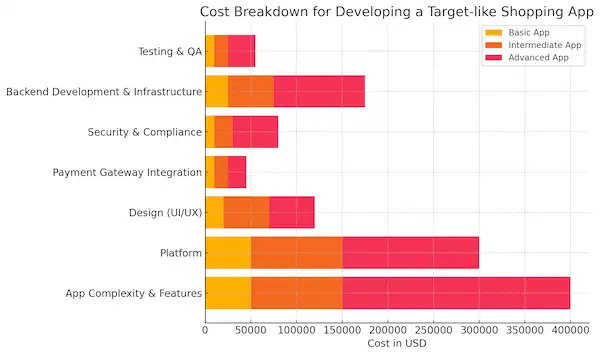
5. Timeframe for Developing a Target-like Shopping App
The development timeframe for an app like Target will depend on several factors, including the app’s complexity, features, and the team’s experience. While it’s possible to build a minimum viable product (MVP) relatively quickly, more complex features like AI-based personalization and multi-platform support will extend the development timeline.
| Development Stage | Basic App (Months) | Intermediate App (Months) | Advanced App (Months) |
|---|---|---|---|
| Initial Research | 1 – 2 | 1 – 2 | 1 – 3 |
| Wireframing & Design | 1 – 2 | 2 – 3 | 3 – 4 |
| Frontend & Backend Development | 2 – 3 | 3 – 4 | 6 – 9 |
| Payment Gateway & 3rd Party Integration | 1 | 1 – 2 | 2 – 3 |
| Testing & Quality Assurance | 1 | 1 – 2 | 2 – 3 |
| Deployment & Launch | 0.5 – 1 | 1 | 1 – 2 |
| Total Timeframe | 3 – 6 | 6 – 9 | 9 – 12+ |
a. Basic App Development Timeline
For a basic shopping app with essential features, the development process typically takes around 3 to 6 months. This includes time for designing, coding, testing, and deploying the app.
- Timeframe: 3 – 6 months
b. Intermediate App Development Timeline
For an app with more advanced features like personalized product recommendations, loyalty programs, and enhanced UI/UX, the timeframe can extend to 6 to 9 months. This includes time for integrating more complex functionalities and ensuring a seamless user experience.
- Timeframe: 6 – 9 months
c. Advanced App Development Timeline
For a full-featured app like Target, which includes AI-based recommendations, real-time order tracking, and multi-platform compatibility, the development process can take up to a year or more. Developing for multiple platforms (iOS, Android, and Web) and incorporating advanced technologies like AR product previews or AI will significantly lengthen the development time.
- Timeframe: 9 – 12+ months
d. Importance of the MVP Approach
To reduce both development time and cost, many businesses opt for an MVP (Minimum Viable Product) approach. This involves developing the core features of the app first, allowing it to launch faster and gather feedback from users. Based on that feedback, you can then add more advanced features and improve the app over time. An MVP can typically be developed in 3 to 5 months, providing a quicker time-to-market and allowing for iterative improvements.
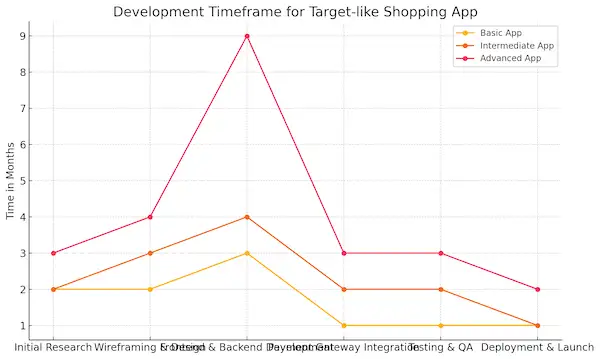
6. Hidden Costs and Maintenance
When budgeting for a Target-like shopping app, it’s crucial to account not only for the upfront development costs but also for the hidden and ongoing expenses that come with maintaining and improving the app over time. These hidden costs can add up, affecting the overall app development budget and requiring careful planning to ensure the app remains efficient and up-to-date.
| Hidden Cost Category | Estimated Cost ($) | Notes |
|---|---|---|
| Hosting & Server Maintenance | 100 – 5,000/month | Depends on app scale and traffic volumes |
| Security Updates & Compliance (GDPR) | 10,000 – 50,000/year | Ensures compliance with privacy regulations |
| Ongoing Feature Updates | 10,000 – 50,000/year | Based on complexity and frequency |
| Bug Fixes & Technical Support | 5,000 – 20,000/year | Includes support for critical bug resolution |
| Marketing & App Store Optimization (ASO) | 10,000 – 100,000/year | Required for consistent visibility and growth |
| Customer Support System | 2,000 – 10,000/year | Depends on user base and level of service |
a. Hosting and Server Maintenance
Once your shopping app is live, you’ll need a robust hosting solution to ensure it operates smoothly and can handle traffic spikes, particularly during peak shopping seasons or promotional events. The cost of hosting will depend on the scale of your app and the expected user base.
- Basic Hosting: For small-scale apps with limited traffic, hosting can cost anywhere from $100 to $500 per month.
- Scalable Cloud Hosting: For larger apps expecting high volumes of traffic, cloud hosting solutions like AWS or Google Cloud could cost between $1,000 and $5,000+ per month, depending on storage, server size, and scalability needs.
b. Security Updates and Compliance
Maintaining user trust requires continuous investment in security. This includes implementing regular security updates, safeguarding sensitive customer data, and complying with international regulations such as GDPR (General Data Protection Regulation) and PCI DSS (Payment Card Industry Data Security Standard). Failure to comply with these regulations could result in hefty fines and damage to your brand’s reputation.
- GDPR and PCI Compliance Costs: Ensuring compliance could add anywhere from $10,000 to $50,000 in one-time costs, with ongoing annual maintenance fees.
- Ongoing Security Patches: Updating security protocols will require a dedicated team or third-party service, which can cost $1,000 to $5,000 per year.
c. Ongoing Feature Updates and User Experience Enhancements
As user expectations evolve and new technologies emerge, it’s essential to keep your app updated with the latest features and improvements. Adding new functionalities, enhancing the user interface, and integrating with emerging technologies such as AI or AR could require additional development work.
- Feature Updates: Each new feature can cost anywhere between $10,000 and $50,000, depending on complexity.
- UI/UX Enhancements: Regularly refreshing the app design to stay current with design trends and improving user engagement can cost $5,000 to $20,000 per update cycle.
d. Bug Fixes and Technical Support
Even the best apps face bugs or glitches from time to time, particularly after new software updates or feature rollouts. Having a team in place to address these issues quickly is critical to ensuring a positive user experience.
- Bug Fixing and Support Costs: Depending on the frequency of issues, this could range from $5,000 to $20,000 annually.
e. Marketing and App Store Optimization (ASO)
Once your app is live, you’ll need to invest in marketing and ASO (App Store Optimization) to attract new users and drive downloads. ASO helps improve your app’s visibility in the Apple App Store and Google Play Store, ensuring it ranks higher in search results and attracts organic traffic.
- Marketing Campaigns: Effective marketing campaigns could range from $10,000 to $100,000 depending on the scale and platform used.
- App Store Optimization: ASO costs range from $1,000 to $5,000, depending on the competition and the optimization techniques required.
f. Analytics and Performance Monitoring
Monitoring the app’s performance is essential for tracking user engagement, identifying areas for improvement, and optimizing features to enhance the user experience. Implementing and maintaining robust analytics tools will require additional investment.
- Analytics Tools (Google Analytics, Firebase): While basic tools may be free, advanced features or premium analytics tools can cost $1,000 to $10,000 annually.
g. Customer Support and Retention
Providing excellent customer service is crucial for retaining users and addressing their queries or issues promptly. This could involve setting up an in-app support system or outsourcing to a customer service provider.
- Customer Support Services: These costs could range from $2,000 to $10,000 annually, depending on the complexity and volume of support required.
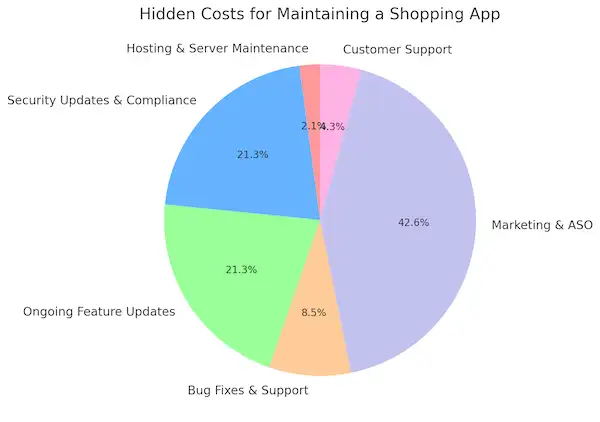
Launching a shopping app for your retail business?
Let us help you create a seamless experience for your
customers with features like product catalogs, shopping carts,
and secure payment options.
7. Monetization Strategies for Shopping Apps Like Target
Building a successful shopping app like Target isn’t just about offering a great user experience; it’s also about generating revenue. Monetization strategies play a key role in offsetting development costs and maximizing profitability. Here are some effective monetization models for a Target-like app:
a. Subscription Models
Offering a subscription-based model for premium users can be a lucrative way to generate recurring revenue. For example, you could offer perks like early access to sales, exclusive discounts, or free shipping to users who subscribe to a monthly or annual plan.
- Example: Premium membership programs like Amazon Prime or Walmart+ have been highly successful in driving customer loyalty and increasing average spending per user.
b. In-App Advertising
Monetizing through in-app advertising can be another profitable route. This involves showing ads to users as they browse through products or while using specific features in the app. Ads could be banners, video ads, or sponsored product listings.
- Tip: Ensure that ads don’t disrupt the user experience to avoid frustrating users. Ads should be carefully placed and relevant to the shopping experience.
c. Affiliate Marketing and Partnerships
Retailers can partner with other businesses to offer cross-promotions or affiliate marketing within the app. For example, linking to related services such as delivery partners, insurance, or accessories for products sold on your app can create additional revenue streams.
d. Premium Features or Memberships
Certain advanced features can be locked behind a paywall, encouraging users to upgrade to a premium version of the app. Features like personalized shopping experiences, VIP customer support, or access to exclusive products can provide value to users while generating additional revenue.
- Premium Features Example: Offering early access to limited-edition items, or virtual personal shopping assistants for premium members.
e. Data Monetization
With the appropriate user consent, the data gathered from users (e.g., shopping habits, preferences) can be anonymized and sold to third parties like market research firms. However, this must be done in compliance with privacy laws such as GDPR to avoid legal repercussions.
| Monetization Strategy | Description | Potential Impact |
|---|---|---|
| Subscription Models | Premium memberships with exclusive benefits | Recurring revenue |
| In-App Advertising | Display ads or sponsored listings within the app | Additional income |
| Affiliate Marketing/Partnerships | Partner with other brands or services for commissions | Cross-promotion |
| Premium Features | Charge for access to advanced features (e.g., VIP services) | Higher engagement & revenue |
| Data Monetization | Sell anonymized user data for market research | Additional income, must comply with GDPR |
Read Also : How to Build an App Like Doctor on Demand: Features, Cost, and Development Process
8. Security and Compliance Considerations
When developing a shopping app like Target, ensuring the security of users’ data is paramount. In today’s digital landscape, consumers are more conscious of how their information is handled, and regulations have become stricter. A secure app builds trust with users and helps avoid legal issues that could result from data breaches or non-compliance. Below are the key security measures and compliance factors to consider when building a Target-like app.
a. Data Encryption for Secure Transactions
One of the most critical aspects of app security is data encryption. Ensuring that sensitive data such as payment details, personal information, and transaction history is encrypted both at rest and in transit is essential for protecting users from cyberattacks.
- SSL/TLS Encryption: All data transferred between the app and servers should be protected by Secure Socket Layer (SSL) or Transport Layer Security (TLS) encryption, ensuring that the data cannot be intercepted by unauthorized parties.
- AES Encryption: At-rest data (stored on the server) should be encrypted using advanced encryption standards (AES), particularly for sensitive information like credit card numbers.
b. Compliance with International Regulations
Every shopping app must comply with global privacy and security regulations to avoid legal complications and penalties. Two of the most important regulations are GDPR (General Data Protection Regulation) and PCI DSS (Payment Card Industry Data Security Standard).
- GDPR Compliance: If your app serves users in Europe, compliance with GDPR is mandatory. This regulation governs how businesses collect, store, and process personal data. Users must provide explicit consent for their data to be used, and you must offer them the ability to access, modify, or delete their information.
- GDPR Fines: Non-compliance with GDPR can result in fines of up to 20 million euros or 4% of global annual revenue, whichever is higher.
- PCI DSS Compliance: Any app that processes payments must comply with PCI DSS, a set of security standards designed to protect credit card information. These standards require secure payment processing, encryption, and regular vulnerability assessments.
- PCI DSS Requirements: Regular audits, encryption of cardholder data, restricted access to sensitive data, and implementation of strong access control measures.
c. Multi-Factor Authentication (MFA)
Incorporating multi-factor authentication (MFA) into your shopping app adds an extra layer of security for users, particularly during the login process. MFA typically requires users to verify their identity through two or more forms of authentication, such as a password and a temporary code sent to their mobile device.
- Benefits of MFA: MFA reduces the risk of unauthorized access by requiring additional verification steps, making it harder for attackers to compromise accounts even if they have the user’s password.
d. Secure Payment Gateways
When processing payments, integrating secure payment gateways such as PayPal, Stripe, Apple Pay, or Google Pay is vital. These gateways not only offer secure processing but also ensure compliance with PCI DSS standards, reducing the burden of securing payment transactions on your app.
- Tokenization: Many payment gateways now use tokenization to enhance security. This involves replacing sensitive payment information with a unique token that can be used only by the payment processor, reducing the risk of data breaches.
e. Regular Security Audits and Vulnerability Testing
To ensure your shopping app remains secure over time, regular security audits and vulnerability assessments are necessary. These audits help identify potential weaknesses in the app’s infrastructure and allow for the timely implementation of security patches.
- Penetration Testing: Conducting penetration tests, where security experts simulate attacks on your app, helps identify vulnerabilities before they can be exploited by real attackers.
- Ongoing Monitoring: Continuous monitoring of the app for suspicious activity is essential to detect and respond to threats in real time.
f. Privacy Policies and Transparent Data Usage
Having a clear and transparent privacy policy is essential for building trust with users. The privacy policy should explain what data is collected, how it’s used, who it’s shared with, and how users can manage their preferences. Ensure that users can easily access this policy within the app.
- User Consent: Always obtain explicit consent for data collection, especially for sensitive information like location data or purchase history.
- Opt-Out Options: Provide users with an option to opt out of certain data collection practices, especially for marketing purposes.
g. Backend Security Measures
While front-end security is critical, backend security is equally important to protect against data breaches. Ensure that your app’s backend infrastructure (servers, databases) is secured through measures like firewalls, encryption, and access control protocols.
- Access Control: Limit access to sensitive data on the backend to authorized personnel only, using role-based access control (RBAC) to ensure that team members have access only to the data they need to perform their job.
- Database Security: Ensure that databases storing sensitive user information are encrypted and regularly updated to avoid vulnerabilities.
9. Scalability and Future-Proofing Your Shopping App
As your business grows, so will the demands on your shopping app. Ensuring that your app is scalable and future-proof from the beginning can save significant costs and headaches down the line. Scalability means that the app can handle increased traffic, user activity, and new features without major overhauls or disruptions.
a. Scalable App Architecture
To support future growth, your app should be built with a scalable architecture. This means the app can easily accommodate more users, data, and transactions as your business expands.
- Microservices Architecture: Instead of building a monolithic app, consider using a microservices architecture where different functionalities are separated into individual services. This makes it easier to update, scale, or modify specific components without disrupting the entire app.
- Cloud Infrastructure: Hosting your app on a cloud platform like AWS, Google Cloud, or Microsoft Azure allows for automatic scaling of resources based on demand, ensuring your app can handle traffic spikes during peak shopping periods or promotional events.
b. Handling Traffic Spikes
Your app must be able to handle sudden surges in traffic, especially during holiday seasons, flash sales, or other promotions. Without proper scaling mechanisms, these spikes can lead to slow performance or even downtime, frustrating users and resulting in lost sales.
- Load Balancing: Implementing load balancing ensures that incoming traffic is distributed across multiple servers, preventing any single server from becoming overwhelmed.
- Auto-scaling: Cloud platforms offer auto-scaling features that automatically adjust server capacity based on real-time demand, helping maintain optimal performance during peak times.
c. Planning for Feature Expansion
As technology evolves and customer preferences change, you’ll likely need to introduce new features or update existing ones. Building your app with future-proofing in mind allows for easy integration of new technologies like AI, AR, or voice search.
- AI and Machine Learning: With AI-driven features like personalized recommendations and predictive analytics becoming more prevalent, planning for the integration of AI into your app’s architecture can ensure that you stay ahead of the competition.
- AR for Virtual Shopping: Augmented reality is an emerging trend in eCommerce, allowing users to visualize products in their real-world environment. Building the app to accommodate future AR integration can enhance the shopping experience.
d. Regular Updates and Improvements
To keep up with changing user expectations and technology trends, regular updates to the app will be necessary. Ensure that your app’s architecture supports frequent updates without requiring a complete overhaul.
- Continuous Deployment: Implementing a continuous deployment pipeline allows for quick and seamless updates to the app without affecting the user experience. This ensures that new features, security patches, and performance improvements can be rolled out efficiently.
e. Future-Proof Design and UI/UX
As design trends evolve, your app’s interface may need updates to stay modern and relevant. While a solid initial design is important, planning for future design updates is equally essential to keep users engaged.
- Modular Design Approach: Using a modular design approach allows for easier updates to specific components of the app’s interface without requiring a complete redesign. This ensures that the app can stay visually appealing and user-friendly as trends change.
10. Success Stories and Case Studies
Looking at real-world examples of successful shopping apps like Target can provide valuable insights into the development process, challenges, and results that you can expect when building your own app. These case studies highlight how businesses have successfully built and scaled shopping apps while overcoming common challenges.
a. Target App: A Benchmark for Retail Shopping Apps
The Target app is widely regarded as one of the most successful mobile shopping apps in the retail space. Target’s app focuses on delivering a seamless, user-friendly experience that mirrors the in-store shopping journey, with additional conveniences that only a mobile platform can offer. Here’s how they did it:
- Personalized User Experience: Target’s app uses AI-based algorithms to offer personalized shopping recommendations based on users’ past purchases and browsing history, significantly increasing customer engagement and boosting sales.
- Omnichannel Integration: The app integrates both online and offline shopping experiences, offering features like in-store pickup, curbside delivery, and real-time inventory updates, which help users make informed decisions and streamline their shopping.
- Loyalty and Rewards: With the Target Circle rewards program, the app incentivizes users to shop more by offering exclusive discounts and cash-back rewards, leading to higher retention and repeat purchases.
- Impact on Revenue: After the launch of the app, Target reported substantial growth in its mobile sales, with app-based orders accounting for a significant portion of its eCommerce revenue.
b. Walmart App: Scaling for Success
Walmart’s app has also seen massive success, following a similar omnichannel strategy to Target. The app focuses on providing a wide range of services to meet customers’ needs, including grocery shopping, home delivery, and easy returns. Key features of Walmart’s app success include:
- AI Integration for Personalized Shopping: Walmart uses machine learning to predict what users might want to purchase, offering smart product recommendations and personalized deals.
- Scalability and Performance: Walmart’s app handles millions of users simultaneously, especially during peak seasons like Black Friday. The app’s architecture ensures that it can scale effectively to handle large amounts of traffic without downtime.
- Seamless Checkout Process: Walmart’s app focuses on a fast, secure, and easy checkout process, with multiple payment options, including its Walmart Pay mobile wallet.
c. Amazon: The King of E-Commerce Apps
As one of the most well-known eCommerce apps globally, Amazon’s mobile app sets the standard for customer experience and app performance. It’s designed to cater to millions of users globally, ensuring that they can browse, shop, and receive personalized recommendations effortlessly. Here’s why Amazon’s app succeeds:
- AI-Powered Recommendations: Amazon’s sophisticated recommendation system is one of the key drivers behind its success. By using AI and machine learning, Amazon can predict what users are likely to buy next and showcase personalized suggestions on the homepage.
- Advanced Search and Filtering: The app’s advanced search features, combined with highly customizable filters, allow users to easily find the products they’re looking for.
- Fast and Reliable Fulfillment: With features like same-day delivery, one-click ordering, and seamless order tracking, Amazon offers unparalleled convenience for users.
d. Lessons Learned from These Success Stories
Building a Target-like shopping app requires not just replicating features but also innovating in areas where your app can stand out. Here are some lessons learned from these successful apps:
- Focus on Personalization: AI-based personalized shopping recommendations can significantly boost user engagement and increase average order value.
- Omnichannel Integration: Allowing customers to easily switch between online and offline shopping experiences, such as offering in-store pickup, is a key factor in driving sales.
- Invest in Scalability: As your app grows, it’s crucial to have a scalable infrastructure in place to handle increased traffic and transactions without compromising performance.
- Enhance User Retention with Loyalty Programs: Implementing a robust rewards system encourages users to return to the app, leading to higher retention rates and customer loyalty.
11. Tips to Reduce the Development Cost
Building a shopping app like Target can be a substantial investment, but there are strategies that can help you manage costs without sacrificing quality. Below are some practical tips to reduce the development cost while still delivering a high-performing, feature-rich app.
a. Start with an MVP (Minimum Viable Product)
Instead of building a fully-featured app from the beginning, start with a Minimum Viable Product (MVP). This is a simplified version of your app with only the core features that are necessary for it to function. An MVP allows you to launch the app quickly and gather feedback from users, which you can use to improve and expand the app later.
- Benefits: An MVP reduces initial development costs and shortens the time-to-market. By focusing only on essential features, you avoid the costs associated with developing and testing more complex functionalities upfront.
b. Use Pre-Built Solutions and APIs
Rather than building every feature from scratch, consider using pre-built solutions and third-party APIs for features like payment gateways, analytics, and customer support. Many of these solutions are well-established, secure, and affordable compared to custom development.
- Example: Instead of developing your own payment gateway, integrate trusted platforms like Stripe or PayPal. For analytics, tools like Google Analytics or Firebase offer robust solutions without the need for in-house development.
c. Prioritize Features for the Initial Launch
When planning the development of your app, prioritize the features that will deliver the most value to users and contribute to the app’s success. Features like a simple checkout process, product search, and secure payments should be developed first. Less critical features, such as advanced loyalty programs or AI-driven recommendations, can be added in future updates.
- Benefit: Prioritizing essential features reduces initial costs and allows you to allocate resources to areas that matter most for early user acquisition.
d. Opt for Cross-Platform Development
Developing an app for both iOS and Android can significantly increase costs. To reduce expenses, consider using cross-platform development tools like React Native or Flutter. These frameworks allow you to build apps that work on both platforms with a single codebase, cutting development time and costs.
- Benefit: Cross-platform development can save you up to 30% in development costs while still delivering a high-quality user experience across multiple devices.
e. Outsource Development to a Skilled Team
Hiring an in-house team can be expensive, especially if you need specialists in various areas such as front-end, back-end, UI/UX, and security. Outsourcing development to an experienced and reputable development team can significantly reduce costs while ensuring high-quality work.
- Benefits: Outsourcing gives you access to a broader talent pool, often at lower rates than in-house teams. You can also scale your team up or down depending on the project’s needs, which provides flexibility.
f. Leverage Open-Source Tools
Open-source tools offer powerful solutions at no cost. From development frameworks to libraries and plugins, many open-source tools are used by leading companies to build scalable and secure apps.
- Example: Open-source frameworks like Laravel for backend development or Flutter for cross-platform mobile development can reduce costs significantly while maintaining performance and scalability.
12. How to Choose the Right Development Partner
Choosing the right development partner is a critical decision that can determine the success or failure of your shopping app like Target. Whether you decide to work with an in-house team, a development agency, or an outsourced partner, it’s essential to evaluate potential collaborators based on their experience, expertise, and approach to your project. Here are the key factors to consider when selecting a development partner.
a. Proven Experience in eCommerce App Development
Your development partner should have a strong track record in building eCommerce apps, particularly ones that are similar in scale and complexity to the app you’re envisioning. Look for developers or agencies that have successfully delivered shopping apps with features like payment gateways, AI-driven recommendations, and omnichannel integration.
- Portfolio Check: Ask to see case studies or portfolio examples that demonstrate their work on eCommerce or retail apps. Analyze the complexity of their previous projects and see how closely they align with the features you want in your app.
b. Expertise in AI-Based Features and Personalization
Given the increasing importance of AI-based personalized shopping experiences, your development partner should have expertise in implementing AI and machine learning technologies. These technologies can be used to create features like personalized product recommendations, customer segmentation, and predictive analytics.
- Technical Knowledge: Ensure the team has experience with AI tools and frameworks, such as TensorFlow, PyTorch, or Google Cloud AI. Ask them how they plan to incorporate AI-driven features into your app and how these features will scale as your user base grows.
c. Strong Design and UI/UX Capabilities
A great shopping app is not only functional but also visually appealing and easy to navigate. The design and user experience (UI/UX) are key factors in determining how users interact with your app and whether they will return. Your development partner should have a dedicated design team or access to skilled UI/UX designers.
- UI/UX Expertise: Check their design portfolio to assess their ability to create intuitive, user-friendly interfaces. Ensure they understand your brand and are capable of creating a design that aligns with your vision.
d. Post-Launch Support and Scalability
Launching your app is just the first step. Your development partner should offer ongoing post-launch support to ensure the app functions smoothly, especially during the critical initial months. They should also be prepared to help you scale the app as your user base grows and new features are introduced.
- Ongoing Maintenance: Confirm that your partner offers ongoing maintenance services, such as bug fixing, security updates, and performance optimization.
- Scalability Planning: Ask them how they plan to future-proof your app, ensuring that it can handle increased traffic, new features, and technological advancements like AI, AR, or VR.
e. Transparent Communication and Project Management
Effective communication is key to a successful development process. Your development partner should have a clear and transparent project management process in place, keeping you updated on milestones, timelines, and any potential challenges.
- Tools and Processes: Ensure they use reliable project management tools like Jira, Trello, or Asana to track progress and maintain accountability. Regular status updates and feedback loops should be part of their communication strategy.
- Dedicated Point of Contact: Having a dedicated project manager or point of contact ensures that you can address any concerns or queries promptly, without communication gaps.
f. Flexibility and Budget Alignment
Your development partner should be flexible and capable of adapting to your needs as the project evolves. They should also be upfront about costs and ensure that the project stays within the agreed-upon budget.
- Cost Transparency: Ensure they provide a detailed cost breakdown upfront, including development, design, testing, and post-launch support. A transparent approach will help avoid unexpected costs later in the project.
- Flexibility in Approach: Whether you need to pivot in terms of features or timelines, the development partner should be able to accommodate changes without derailing the project.
g. Client Testimonials and Reviews
One of the best ways to gauge a development partner’s reliability and capability is by checking client testimonials and third-party reviews. Look for feedback on their technical skills, communication, adherence to timelines, and ability to deliver on their promises.
- Third-Party Reviews: Check platforms like Clutch, GoodFirms, or Google Reviews for unbiased feedback from previous clients. High ratings, positive reviews, and successful case studies are strong indicators of a trustworthy partner.
h. Location and Time Zone Considerations
If you’re working with an outsourced team or development partner in a different time zone, consider how that will impact communication and collaboration. While many agencies are skilled at managing time zone differences, it’s important to set clear expectations about availability and response times.
- Time Zone Compatibility: Ensure that your development partner is able to provide sufficient overlap in working hours to facilitate real-time communication, especially during critical phases like testing and deployment.
Conclusion
Building a shopping app like Target is a complex but rewarding investment that requires careful planning, budgeting, and the right team. The cost to create a Target-like app can vary significantly based on factors such as app complexity, platform choice, and features. However, by leveraging strategies like starting with an MVP, using pre-built solutions, and prioritizing essential features, businesses can reduce costs while still delivering a high-quality app.
From personalizing the shopping experience with AI-driven recommendations to ensuring compliance with global security standards, the journey to building a successful app involves multiple stages. By selecting the right development partner and continuously optimizing the app based on user feedback, you can ensure that your app remains competitive, scalable, and profitable in the long term.
The key takeaway is that a Target-like shopping app isn’t just about matching features—it’s about delivering an experience that resonates with your users, scales with your business, and adapts to the evolving retail landscape.
If you’re ready to bring your shopping app vision to life, whether it’s a Target-like app or a custom eCommerce platform, Miracuves is here to help. Our team of experts has extensive experience in building scalable, high-performance shopping apps tailored to your business needs. From designing intuitive user interfaces to integrating advanced features like AI-powered recommendations and secure payment gateways, we’ll guide you through every step of the development process.
At Miracuves, we prioritize quality, security, and innovation to deliver an app that not only meets your expectations but exceeds them. Let’s turn your idea into a reality. Contact us today to discuss your project and get a customized development plan that aligns with your budget and goals.
Get started on your shopping app journey with Miracuves—your trusted partner in building future-proof mobile solutions.
Launching a retail app?
See how our platform can help you integrate features like personalized recommendations, shopping cart management, and customer profiles—just like Target.
FAQs
How much does it cost to develop a shopping app like Target?
The cost to develop a shopping app like Target depends on factors such as app complexity, features, platform (iOS, Android, Web), and development team location. Typically, a basic app can cost between $30,000 to $50,000, while more advanced apps with AI-based features, multi-platform support, and custom designs can cost anywhere from $100,000 to $250,000 or more.
What features are necessary for a Target-like shopping app?
Essential features for a Target-like shopping app include user registration, product search with filters, a secure shopping cart and checkout, payment gateway integration, AI-based personalized shopping recommendations, push notifications, loyalty programs, and multi-platform compatibility (iOS, Android, Web). Advanced features like real-time order tracking and customer support add further value.
How long does it take to build a shopping app like Target?
The time required to build a shopping app like Target depends on the app’s complexity. A basic app can take 3 to 6 months, while an intermediate app with more advanced features may take 6 to 9 months. An advanced app with full-scale features, AI integration, and multi-platform support can take 9 to 12 months or longer.
What are the ongoing costs of maintaining a shopping app like Target?
Ongoing costs for maintaining a shopping app include hosting and server maintenance ($100 – $5,000 per month), security updates and compliance (up to $50,000 per year), feature updates ($10,000 – $50,000 annually), bug fixes and technical support ($5,000 – $20,000 annually), and marketing and app store optimization (up to $100,000 per year).
Can I reduce the cost of developing a Target-like shopping app?
Yes, you can reduce development costs by starting with a Minimum Viable Product (MVP) to focus on core features first, using pre-built solutions and APIs instead of building everything from scratch, and opting for cross-platform development frameworks like React Native or Flutter, which allow for a single codebase to be used on both iOS and Android.
What security measures are needed for a shopping app like Target?
A Target-like shopping app must implement robust security measures such as SSL/TLS encryption for secure data transmission, GDPR and PCI DSS compliance to protect personal and payment information, and multi-factor authentication (MFA) for added login security. Regular security audits and vulnerability testing should also be part of ongoing maintenance.



